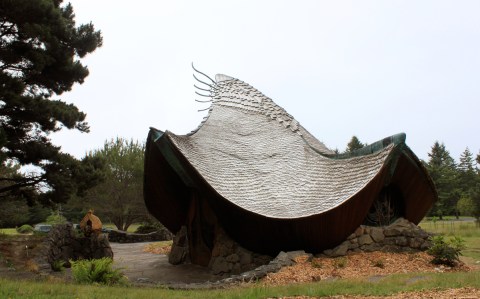Archive for June, 2011
Sea Ranch Chapel
While I was at Salt Point, I visited the Sea Ranch Chapel just north of there. The chapel’s a fantastic building designed by San Diego architect James T. Hubbell, commisioned by two sea Ranch residents who wanted to create a ‘nondenominational sanctuary for prayer, meditation, and spiritual renewal.’ I love the form and the blending of materials.
The design was inspired by the drawings of a local artist and is said to be based on winged forms. It also has a bit of shell motif going, though it’s of course abstract enough to offer a variety of interpretations. Personally, I think it resembles a brugmansia flower.
The Hubbell website says the supervisor on the project had experience as a boat builder, which makes a lot of sense; the framing looks like it’s for a boat, and the finished building looks somewhat like a sea vessel sitting on a cradle of rock. The moss rock (aka Sonoma fieldstone) is actually a facade over a cinder block wall, but the batter makes it look structural.
The section and the construction photo are from the chapel’s website, which also has a nice aerial photo of the building.
The interior is as striking as the exterior, with a flagstone floor, stained glass windows, and lots of beautiful woodwork. The windows and the wood made the building feel warm, even though the sky still was gray with its coastal-morning haze.
It’s all very compelling and a steady flow of people visited while I was there, drawn off the highway to investigate. You don’t really see many buildings that combine rock and wood and glass and metal in such a unique way. Really well done.
Salt Point State Park
I took a couple of days this week to go climbing and hiking at Salt Point State Park up the coast between Jenner and Sea Ranch. I’d never been before, it’s a little far for a day trip, but now the impending closure of so many state parks has got me motivated to check out some of the parks I’ve always meant to visit. Salt Point isn’t one of the ones that will be closing, but that’s partly because they have already cut back many of the services. The closures didn’t really affect my visit, I had a great time, but it was a reminder of how things are trending. But in any case, I wasn’t dwelling on that during my trip, mostly I was just enjoying the park. Classic Northern California coastline, lots of wildflowers in bloom, and I was lucky to enjoy perfect weather. I’m not sure photos can show how exceptionally pleasant it was.
Salt Point was a quarry in the 1850’s. Sandstone slabs were split and shipped down to San Francisco to use as paving and wall stone; you can still see drilling scars on some of the rocks.
It’s great to see a former quarry site looking so beautiful.
A Redwood City Garden
I don’t know about following the master with one of our own gardens, but the same day as I visited the Tommy Church garden, I also took photos at a garden we installed three years ago in Redwood City. The house is on the market, so this was a good opportunity to photograph it.
It was a good opportunity, but it also a farewell to the garden, too. Before I started working in gardens, I really had no idea how often Americans move. The statistics say that 1 in 5 Americans move every year, and it sometimes seems that 1 in 5 of our clients move every year as well. The real estate listing called this an ‘Oh, Wow’ Rear Garden,’ which sounds good, but it also said the paver patio was made of stone, so the real estate agents might not have the most reliable opinions. I was going to link to the listing, but it’s already been taken down; there was a sale pending last I heard, so the house has probably sold already.
The stonework is all veneer, thin pre-made panels made of saw-cut stone. If you look closely you can see the seams. We were going to do dry-stack walls, but when I was walking around with the clients at the stoneyard, it became clear that this was the only look they liked. A bigger carbon footprint, a bit more expensive, and a much slicker look than dry-stack. Some more photos and a plan of the garden are below. (more…)
You are currently browsing the DryStoneGarden blog archives for June, 2011.



















